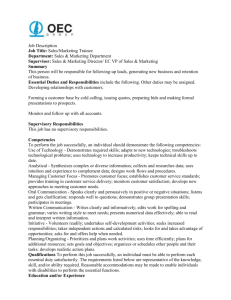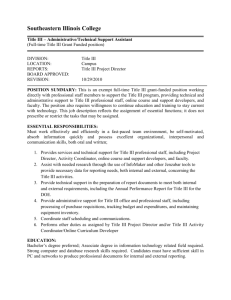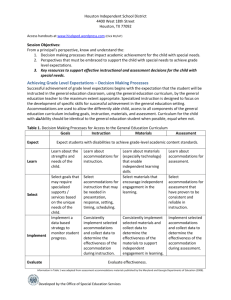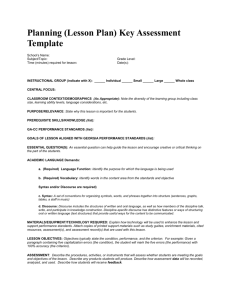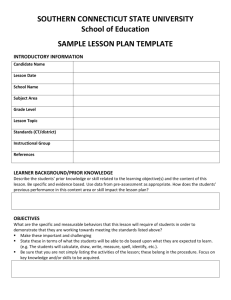EDSP 301 Lecture - California State University, Bakersfield
advertisement
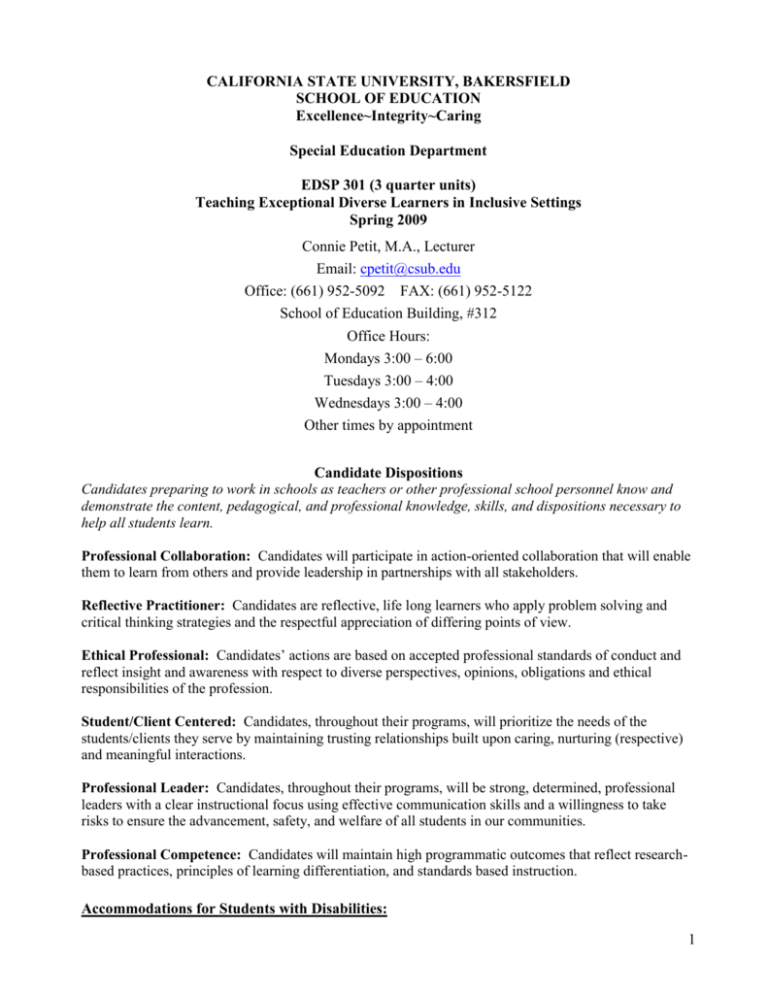
CALIFORNIA STATE UNIVERSITY, BAKERSFIELD SCHOOL OF EDUCATION Excellence~Integrity~Caring Special Education Department EDSP 301 (3 quarter units) Teaching Exceptional Diverse Learners in Inclusive Settings Spring 2009 Connie Petit, M.A., Lecturer Email: cpetit@csub.edu Office: (661) 952-5092 FAX: (661) 952-5122 School of Education Building, #312 Office Hours: Mondays 3:00 – 6:00 Tuesdays 3:00 – 4:00 Wednesdays 3:00 – 4:00 Other times by appointment Candidate Dispositions Candidates preparing to work in schools as teachers or other professional school personnel know and demonstrate the content, pedagogical, and professional knowledge, skills, and dispositions necessary to help all students learn. Professional Collaboration: Candidates will participate in action-oriented collaboration that will enable them to learn from others and provide leadership in partnerships with all stakeholders. Reflective Practitioner: Candidates are reflective, life long learners who apply problem solving and critical thinking strategies and the respectful appreciation of differing points of view. Ethical Professional: Candidates’ actions are based on accepted professional standards of conduct and reflect insight and awareness with respect to diverse perspectives, opinions, obligations and ethical responsibilities of the profession. Student/Client Centered: Candidates, throughout their programs, will prioritize the needs of the students/clients they serve by maintaining trusting relationships built upon caring, nurturing (respective) and meaningful interactions. Professional Leader: Candidates, throughout their programs, will be strong, determined, professional leaders with a clear instructional focus using effective communication skills and a willingness to take risks to ensure the advancement, safety, and welfare of all students in our communities. Professional Competence: Candidates will maintain high programmatic outcomes that reflect researchbased practices, principles of learning differentiation, and standards based instruction. Accommodations for Students with Disabilities: 1 The instructor will make reasonable accommodations for students who have a documented problem that interferes with successfully completing this course. It is your responsibility to request accommodation before assignments are due. To request academic accommodations due to disability, please contact the Antelope Valley Campus Office of Services for Students with Disabilities (SSD) as soon as possible. Their office is located in Bldg. 200, and they may be reached at 661-952-5061 (voice) or 661-952-5120 (tdd). If you have an accommodation letter from the SSD Office documenting that you have a disability, please present the letter to me during my office hours so we can discuss the specific accommodations that you might need in this class. Course Description: This course presents an overview of the role and responsibilities of elementary and secondary teachers in meeting the educational needs general of exceptional and diverse learners in general education classrooms. Students will be given the opportunity to study the special education process, characteristics of exceptional, diverse, and at-risk learners, and the use of effective differentiated instructional guidelines, practices and accommodations. Emphasis will also be focused on management considerations, evaluative and collaborative activities, curriculum modifications, and laws, procedures and regulations pertaining to the education of exceptional learners. Required Text: Vaughn, S. Bos, C. S. & Schumm, J. S. (2007). Teaching Exceptional, Diverse, and AtRisk Students in the General Education Classroom (4th Edition). Boston, MA: Allyn and Bacon. Note: The publisher of this book provides free resources associated with our text. You will find practice tests and other useful activities that supplement the information at the following website: http://www.ablongman.com/vaughn4e Required Electronic Portfolio tool: College LiveText Edu Solutions www.livetext.com Order from Runner Bookstore 661.654.2273 $98.00 + $6.95 shipping (shipped to student in 2-3 days) or online directly from www.livetext.com Recommended Reading: Friend, M. & Bursuck, W. D. (2005). Including Students with Special Needs: A Practical Guide for Classroom Teachers. (4th Edition). Boston, MA: Allyn and Bacon. Lewis, R. B. Z& Doorlag, D. H. (2005). Teaching Special Students in General Education Classrooms. (7th Edition). Upper Saddle River, NJ: Merrill, Prentice-Hall. Winebrenner, S. (2005). Teaching Kids with Learning Difficulties in the Regular Classroom. Minneapolis, MN: Free Spirit Publishing. Wood, J. W. (2002). Adapting Instruction to Accommodate Students in Inclusive Settings. (Fourth Edition). Upper Saddle River, NJ: Merrill, Prentice-Hall. Journals for Review: Exceptional Children Journal of Applied Behavior Analysis Journal of Mental Retardation Behavioral Disorders Learning Disabilities Research and Practice Teacher Education and Special Education Focus on Exceptional Children Journal of Learning Disabilities Journal of Special Education Learning Disabilities Quarterly Teaching Exceptional Children 2 Course Objectives/Competencies (Matching CTC Standards): The candidate will be able to: 1. demonstrate basic knowledge and understanding of major categories of exceptionalities including the students with disabilities and giftedness(14a); 2. discuss relevant and state and federal laws, practices, and procedural safeguards, and regulations pertaining to the education of exceptional populations, as well as the general education teacher’s role and responsibilities in Individual Education Program (IEP) process, including: identification; referral; assessment; IEP planning and meeting; implementation; and evaluation(14b). 3. demonstrate the basic knowledge and skills in assessing the learning and language abilities of students with special needs in order to identify students for pre-referral and referral to special education programs and gifted and talented education programs(14c); 4. select and use appropriate instructional materials and technologies, including assistive technologies, and differentiated teaching and management strategies to meet the needs of special populations including exceptional, diverse and at-risk learners in the general education classroom(14d); 5. demonstrate the skills to plan, deliver and evaluate instruction to those identified as students with special needs and/or those who are gifted and talented that will provide these students access to the core curriculum(14e); 6. demonstrate the skills to know when and how to address the issues of social integration for students with special needs who are included in the general education classroom(14f). Course Requirements: 1. Attendance (200 pts): Active class participation and timely attendance. 2. Inclusion Report (100 pts.): Due April 28 (Tues) Write a 2 – 3 page paper on inclusion. This assignment has two parts, a one page report on what inclusion is, and an informal assessment of how inclusion is implemented in the district you work for, sub in or live in. For the assessment, you are to ask three (3) different people the questions contained at the end of this paragraph. One person must be a special education teacher, one a general education teacher, and I’d like the 3rd to be a site administrator (principal, vice-principal, asst. principal, or designee, etc.) If you can’t wrangle time to speak with an administrator, then ask another gen ed teacher. This is an informal interview that should only take a few minutes per person. Please don’t make this more of a chore for yourself (or the person you asking) than it needs to be. In other words, don’t ask for something in writing, just do it verbally and quickly. Here’s what I’d like you to ask: 1. Does this school have an inclusion program? 2. How does the inclusion program work? 3. What types of students are placed in an inclusion model? 3. Curriculum Modification and Accommodations (100 pts.): Due: 5/12 (Tues) Interview one or more special education teachers and write a report regarding their curriculum modification and special accommodation efforts. The interview can be done at the same time as the classroom observation (see assignment #3) or can be an entirely different teacher from the one you observe. Write the report in a narrative (essay, not Q & A) format (2-3 pages, double spaced). Please do not include a title page. The report should include a reflection portion as well as information regarding the following questions but feel free to add others: Introduce me to your interviewee 3 i. School, grade level, whether class is mild/moderate or moderate/severe ii. Length of time teaching and type of credential(s) What types of disabilities do children that you teach have? What is the biggest obstacle that you face as a special education teacher? What types of test modifications do you make for your students? What types of curriculum modifications or accommodations do you make to teach content areas? How do you think these differ from general education classrooms? What advice do you give future general education teachers with regards to making accommodations and modifications? What can I do now to better prepare for my future classroom? Why did you choose special education? Reflection: Reflect on overall demeanor of teacher and reaction to working with exceptional students. What is your response to his/her responses? How would you apply what you have heard to yourself and your future practices? 4. Special Education Classroom Observation Report (200 pts)*: Due: 5/26 (Tues) In order to broaden and intensify your knowledge of current practices, trends and issues in teaching exceptional learners, you are asked to visit one of the many classrooms or programs that work with exceptional children, adolescents or young adults. This can include visiting a public or private school special education classroom or program (elementary, middle, or secondary) that serves students with exceptionalities including inclusion classrooms, resource and special day classrooms. Report is to be 4-5 pages written using a narrative format and should include a reflective portion. Please do not include a title page. The following areas should be addressed and included as subtopics (headings) in the body of your paper: Introduction (Discuss date, time, school and setting of observation, grade level(s), number of students, types of disabilities if determinable) Physical Organization of Room (How was the room organized? Was it easy to access students or materials? Was it appropriate for population served, etc.?) Curriculum Content and Instructional Materials (What was being taught and what was used to teach it? Can you identify accommodations made to materials? Were the materials used grade appropriate?) Instructional Methods or Strategies (How was the lesson taught? Could you identify accommodations? What role did the paraeducator play, if any? How well did the students respond?) Behavior Management Strategies (Was there a classroom management/positive behavior plan in place? How were behaviors handled?) Reflection (This is a very important component of the report. Consider the following questions when you write your reflection: Does it reflect the best practices discussed in the textbook? How? Was the instructor/instruction effective? What would you do differently if you were the teacher? Specify what, if anything, you will use in your own classroom) Observations must be of at least one hour or one class period in duration. Please remember that this observation is for your learning purposes. Try to learn something and report what you have learned. You are not there to criticize the teacher. You should appreciate the opportunity for this observation and appreciate that they gave you permission to observe their classes. 4 The scoring rubric is included in the template used to submit this project in LiveText. This Classroom Observation Report has been designated the Signature Assignment for EDSP 301 and requires the posting of this assignment to LiveText. *In order to pass this course, this Signature Assignment must be posted to LiveText unless excused in writing by the instructor. If you encounter any difficulties in arranging to observe a class, please contact the instructor immediately. 5. Final Examination (200 pts.). GRADING POLICY Assignment Attendance/participation Inclusion Report Mod/Accom. Interview Classroom Observation Final exam Total Grading Scale: A = 94% (or higher) B+ = 87-89% B- = 80-82% C = 73-76% D = 69-60% Individual Point Value 200 100 100 200 200 800 AB C+ CF = = = = = Due Date Ongoing April 28 May 12 May 26 June 9 My Grade 90-93% 83-86% 77-79% 70-72% 59% or below Course Policies: 1. Attendance is required and rewarded with points. If you must miss the class for a professional reason, please notify the instructor in advance. Missing for other reasons does not require notification. Tardiness and/or leaving before dismissal results in loss of points. 2. You are responsible for information covered in assigned readings, class lectures, handouts, out-of-class assignments, and in-class discussions and activities. If you are absent from class, it is your responsibility to get the material missed. Find a "buddy" who can pick up handouts and copy notes for you if you are not there. 3. All students are expected to have access to e-mail and to regularly check for communications from the instructor. 4. Assignments submitted after the due date will be penalized 25% of the point value for each week or portion of a week they are late. 5. Tests may not be made-up unless you obtain prior approval from the instructor or have a serious and compelling reason for missing the test. 6. It is unfortunate that this must be mentioned, but past experience makes it necessary. Chitchatting in class will not be tolerated. 7. Cell phones are to be turned off or put on vibrate during class time. 8. As per CSUB policy, children may not attend classes intended for adults (due to liability reasons as well as discussions that may not be suitable or appropriate for children). 5 9. All papers should be typed using a standard 12 pt font, one inch margins and double spaced. 10. In order to pass this course, students must post their signature assignment on LiveText. WEEKLY CLASS SCHEDULE and DISCUSSION TOPICS Tentative Topics of Discussion Wk 1 Wk 2 Course introduction Syllabus Special Education and Inclusive Schooling IDEA and Vocational Rehabilitation Act & IEP Responsibilities of Classroom Teachers Role of Collaboration in Meeting Students’ Special Needs Collaborating and Coordinating with Other Professionals and Family Working with Other Professionals Critical Communication Skills Working with Parents Communication and Pervasive Developmental Disorders Speech & Language Disorders & Identification IEPs and the Classroom Teacher Wk 3 Wk 4 Wk 5 Wk 6 Learning Disabilities or Attention Deficit Hyperactivity Disorder (ADHD) Definitions & Characteristics Identification & Assessment Instructional Guidelines and Accommodations Emotional and Behavioral Disorders Definitions Characteristics Identification and Assessment Instructional Guidelines and Accommodations Managing Student Behavior and Promoting Social Acceptance Basic Principles of Managing Student Behavior Establishing the Classroom Climate Practices for Providing Positive Behavioral Support Enhancing Students’ Self-Concept Teaching Social and Self-Management Skills Inclusion Report Due Autism Spectrum Disorders/Pervasive Developmental Disorders Definitions & Characteristics Identification & Assessment Curricular and Instructional Guidelines Developmental Disabilities: Mental Retardation, Severe Disabilities Definitions & Characteristics Identification & Assessment Assigned Chapters 1&2 4 3 5 & 10 6 7&8 6 Wk 7 Wk 8 Wk 9 Wk 10 Instructional Guidelines and Accommodations Visual Impairments, Hearing Loss, Physical Disabilities, Health Impairments, or TBI. Characteristics Identification and Assessment Instructional Guidelines and Accommodations Curriculum Modification Interview Due Planning and grouping strategies for special learners. Planning Process Model. Course Planning Routine and the Planning Pyramid. Traditional grouping practices and current trends. Advantages and disadvantages of same- and mixed-ability groups. Cooperative grouping. Culturally and Linguistically Diverse Students Multicultural Education Linguistic Diversity and Second Language Acquisition At Risk Students Defining Students at Risk Programs for Students at Risk Programs for Students at Risk Gifted and Talented Defining Giftedness Characteristics of Students who are Gifted and Talented Programs for Students who are Gifted and Talented Instructional Guidelines and Accommodations Classroom Observation Due Facilitating Reading, Writing and Math Current trends and issues in curriculum and instruction. Components of effective instruction. Strategies for student improvement Teaching in the content areas Promoting student participation Adapting textbooks Success in homework, class assignments, and tests 9 11 & 12 13, 14, 15, 16 Final Exam Excerpts taken from the CSU Bakersfield Campus Catalog 2007-2009 RIGHTS AND RESPONSIBILITIES OF STUDENTS (p. 81-82) Academic Integrity - The principles of truth and integrity are recognized as fundamental to a community of teachers and scholars. The University expects that both faculty and students will honor these principles and in so doing will protect the integrity of all academic work and student grades. Students are expected to do all work assigned to them without unauthorized assistance and without giving unauthorized assistance. Faculty have the responsibility of exercising care in the planning and supervision of academic work so that honest effort will be encouraged and positively reinforced. There are certain forms of conduct that violate the university’s policy of academic integrity. ACADEMIC DISHONESTY (CHEATING) is a broad category of actions that involve fraud and deception to improve 7 a grade or obtain course credit. Academic dishonesty (cheating) is not limited to examination situations alone, but arises whenever students attempt to gain an unearned academic advantage. PLAGIARISM is a specific form of academic dishonesty (cheating) which consists of the misuse of published or unpublished works of another by claiming them as one’s own. Plagiarism may consist of handing in someone else’s work, copying or purchasing a pre-written composition and claiming it as one’s own, using paragraphs, sentences, phrases, words or ideas written by another without giving appropriate citation, or using data and/or statistics compiled by another without giving appropriate citation. Another example of academic dishonesty (cheating) is the SUBMISSION OF THE SAME, or essentially the same, PAPER or other assignment for credit in two different courses without receiving prior approval from the instructors of the affected courses. When a faculty member discovers a violation of the university’s policy of academic integrity, the faculty member is required to notify the CSUB Dean of Student Life and CSUB Student Conduct Coordinator and the student(s) involved. A course grade of ‘F’ may be assigned or another grade penalty may be applied at the discretion of the course instructor. Additional academic sanctions are determined by the student conduct coordinator. Academic sanctions may include disciplinary probation, suspension, permanent expulsion from the university or from the California State University system, administrative hold on the release of records, and withholding a degree. Disciplinary probation shall be noted on the student’s formal academic record only for the duration of the probationary period. Disciplinary suspension and expulsion are a part of the student’s permanent record. Civility and Respectful Conduct - The classroom is essential for the achievement of academic freedom, the pursuit of truth, and the development of students. Because of its importance, students are expected to exhibit respect for the views of others, the professionalism of the instructor, and the goals of academic freedom whenever they are in the classroom. Faculty are obligated to recognize and respect student diversity, ideas, perceptions, and opinion. At the same time, faculty have a fundamental responsibility to maintain the integrity of the learning environment. When confronted by unreasonable disruption in the classroom, faculty are expected to initiate actions to correct such conditions. Such actions may result in disciplinary action ranging from removal from the classroom to formal disciplinary sanctions, including probation, suspension, or expulsion. 8
